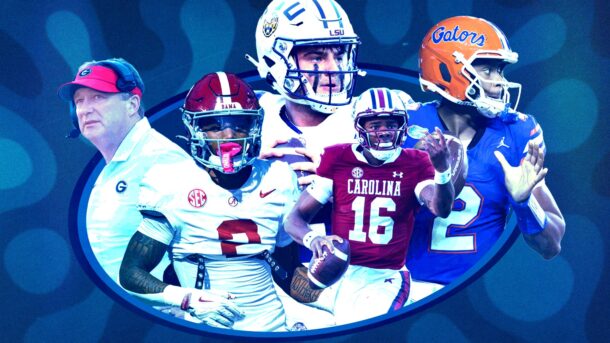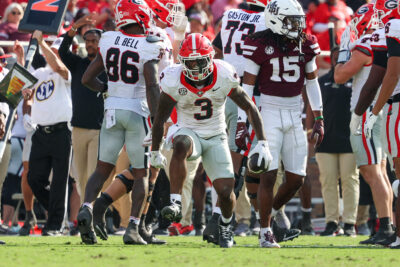
Every season, statistical outliers reveal themselves.
An offense that was bad one year before suddenly explodes and become a juggernaut, as was the case with Missouri, or a good defender is often in the right spot and becomes a household name like Vanderbilt’s Zach Cunningham.
Some of these instances are the result of a team’s overall improvement, a new scheme or the perfect combination of talent and circumstance.
Depending on the reason for such a statistical outburst, it is either repeatable or an anomaly. A good offense is more likely to repeat its performance the next season, but it’s much harder to duplicate a statistic that requires luck or multiple factors to play out.
Here are eight stats that won’t be replicated in the SEC during the 2017 season.
1. Alabama’s non-offensive touchdowns: Not only will an SEC team fail to record 15 non-offensive touchdowns next season, it might be a long time before we see any FBS team come close to that number. One of the craziest storylines of the 2016 season was made possible by an extremely talented, veteran defense playing at the top of its game throughout the entire season. Let’s also consider that there is a certain amount of good fortune that goes into a number like this. Alabama’s six touchdowns off interceptions, five off fumble returns and four from punt returns may end up as the lasting legacy of this dominant squad.
2. Tennessee’s 36 points per game: Alabama isn’t the only program losing a lot of talent on one side of the ball. Many of Tennessee’s best playmakers have moved on, which means the Vols will take a step back on offense next year. Tennessee finished second behind Alabama with 36.4 points per game in 2016, but it will have to replace Joshua Dobbs, Alvin Kamara, Josh Malone and Jalen Hurd, among others, who accounted for 252 of the Vols’ 473 points last season. Very few teams not named Alabama are able to lose over 53 percent of their scoring production and reload the next season.
Man, Tennessee's offense is #explosive when Joshua Dobbs calls his number early and often. #UKvsTenn pic.twitter.com/d4GLg4Pach
— Marc Whiteman (@MarcWYFFNews4) November 12, 2016
3. South Carolina’s 20 points per game: If Tennessee’s offense is like a werewolf coming back to human form, then a full moon is about to shine brightly for South Carolina.
The Gamecocks finished last in the SEC in scoring in 2016. That won’t happen again. Early-season quarterback issues and nagging injuries plagued the Gamecocks’ offense at the start of the fall. Once Jake Bentley got behind center and players became healthier, however, the offense started to show what it was capable of.
After failing to score more than 20 points in any of their first six games, the Gamecocks surpassed 30 points in four of their final seven games. South Carolina also found several perimeter weapons on the recruiting trail who could make an early impact on offense. This team won’t be held under 20 points very often next year.
4. Auburn’s 169 passing yards per game: Gus Malzahn’s offense will never be considered pass-happy, but it seems like Auburn has been stuck in a “chicken or the egg” scenario recently. Do the Tigers have few passing yards because of their scheme, or are their totals limited by poor quarterback play? It’s likely a combination, but that should change in 2017.

Transfer quarterback Jarrett Stidham (above) is the favorite to win the starting job, and he is easily the best passer the Tigers have had since Cam Newton. What should make Stidham so effective, however, is his ability to run with the ball. He is the perfect type of quarterback for Malzahn’s system, and his dual-threat skills should open up the passing game.
5. Nick Fitzgerald won’t finish second in rushing yards: Only Newton and Johnny Manziel have gained more rushing yards at the quarterback position in a season than Fitzgerald did in 2016. Including the bowl game, Mississippi State’s quarterback ran for 1,375 yards, 12 fewer than the SEC leader, Derrius Guice.
While Fitzgerald is capable of putting up similar numbers next season, it’s not likely he gains more than all but one player. There are a slew of returning running backs in the SEC who are talented enough to have monster years. Plus, defenses will be better prepared to slow down Fitzgerald in 2017, and Mississippi State will likely look to lighten his workload.
6. Georgia won’t finish last in plays of 20-plus yards: With a true freshman quarterback and a running back coming off injury in a new scheme behind a below-average offensive line, Georgia didn’t produce many explosive plays in 2016. The Bulldogs finished last in the SEC with only 48 plays of 20 yards or more. To make matter worse, Georgia’s most explosive player, slot receiver Isaiah McKenzie, left early for the NFL.
Still, the Bulldogs will likely look a bit more explosive next fall. For starters, Jacob Eason should be more comfortable, and he has plenty of arm strength to push the ball downfield. The Bulldogs have one of the deepest backfields in college football, and they invested heavily at receiver on the recruiting trail. If the offensive line can just be average, the chunk plays should be there.
#Dawgs #TBT 2. Nick Chubb returns with a vengeance!
222 yds rushing including this 55-yd TD #ChubbStronghttps://t.co/SqHepWSQEW#GoDawgs— GATA Dawgs (@BassinDawg) December 8, 2016
7. Kentucky allowing 31.3 points per game: Kentucky has become a popular dark horse pick in the SEC East next season, partly because of its dynamic running game. While Benny Snell should have fans excited after a strong freshman campaign, the Wildcats’ defense might be the biggest reason for optimism. Kentucky’s defense ranked 11th in the SEC at giving up points, allowing 31.3 per game.
What the stats don’t reveal, however, is that there is a lot of veteran talent on hand for new defensive coordinator Matt House to work with. The Wildcats have nine starters returning and most of the projected depth chart is filled with upperclassmen. Players like Jordan Jones, Josh Allen, Denzil Ware and Mike Edwards have the individual talent. Now, they just need to come together as a unit.
8. A tight end won’t finish in the top 5 in receiving yards: The 2016 season was the last for several excellent tight ends in the SEC. Evan Engram, O.J. Howard and Jeremy Sprinkle were nice offensive pieces throughout their four-year careers. While Howard and Sprinkle became increasingly productive for Alabama and Arkansas, respectively, it is Engram who will be the hardest to replace.
During his senior season at Ole Miss, Engram caught 65 passes for 926 yards and eight touchdowns. His receiving yards were the fifth-most in the SEC, which is something that doesn’t happen often. Since 2008, only Florida’s Aaron Hernandez cracked the top 5, when he gained 850 yards in 2009. South Carolina’s Hayden Hurts seems like the most-likely candidate to join that list, but given the Gamecocks’ variety of weapons and the receiver talent returning, it’s a bit of a longshot.






